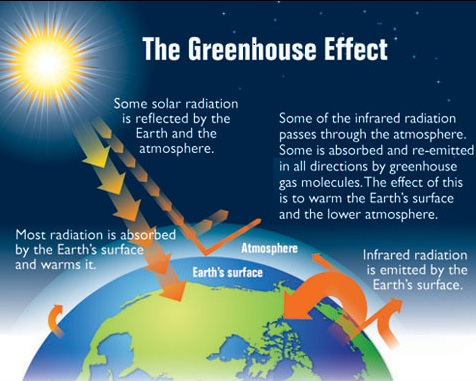See this page for information on District activities relating to climate change.
New:
- View What We Know: The Reality, Risks and Response to Climate Change from the American Association for the Advancement of Scientists
- Download Climate Change 2013 The Physical Science Basis – Summary for Policymakers from the Intergovernmental Panel on Climate Change.
- See February 2014 report: Climate Change Evidence & Causes: An Overview from the Royal Society and the U.S. National Academy of Sciences.
Calculate your personal greenhouse gas emissions on the Cool California state website, or on the U.S. Environmental Protection Agency website.
For the latest on California’s climate change actions, see the California Climate Change Portal website.


Background: The Greenhouse Effect
Impacts of Climate Change in California
What Can One Person Do?
Grants for Teachers
Downloads, Links, Recent Reports and Developments
The world’s average temperature is up 1.4°F (0.8°C) since 1850; some of the coldest, most remote spots have warmed up much more. This phenomenon is referred to as global warming, or global climate change. The Intergovernmental Panel on Climate Change has concluded that the global climate is changing at a rate unmatched in the past 1,000 years, and that this change is due to human activity, primarily the burning of fossil fuels, producing a buildup of greenhouse gases.
Background: The Greenhouse Effect
 The “greenhouse effect” refers to the natural process by which the atmosphere traps heat to keep the earth warm enough to sustain life. The atmosphere contains gases that trap heat; these are known as greenhouse gases. Greenhouse gases include carbon dioxide, methane, nitrous oxide, hydrofluorocarbons, and others. The greenhouse effect is depicted below.
The “greenhouse effect” refers to the natural process by which the atmosphere traps heat to keep the earth warm enough to sustain life. The atmosphere contains gases that trap heat; these are known as greenhouse gases. Greenhouse gases include carbon dioxide, methane, nitrous oxide, hydrofluorocarbons, and others. The greenhouse effect is depicted below.
The burning of fossil fuels–such as gasoline to power vehicles or coal to generate electricity–releases greenhouse gases. These human-caused releases of greenhouse gases are driving global warming. Most of these emissions are in the form of carbon dioxide. In the United States, electricity generation is the largest source of greenhouse gas emissions, followed by transportation.
Graphic from U.S. Environmental Protection Agency document “Climate Indicators in the U.S.”
Impacts of Climate Change in California
Note: For current information, see the California Climate Change portal: www.climatechange.ca.gov.
A 2006 report, Our Changing Climate – Assessing the Risks to California, projected effects of climate change in the state under three different emissions scenarios – a small increase in greenhouse gas emissions, a medium-to-large increase, and a larger increase. The report, issued by the California Climate Change Center (under the California Energy Commission’s Public Interest Energy Research Program) projected a warming of between 1 and 2.3° F in the state in the next few decades, and a warming ranging from 3 to 10.5° F by the end of the century, depending on the increase in greenhouse gas emissions.
The report projected climate change impacts in the state, including:
- increased air pollution
- intensified heat waves
- an expanded range of infectious diseases
- a decline in the Sierra Nevada snow pack, with resulting impacts on water supply, ecosystems, and hydropower
- a range of agriculture impacts, including expanded ranges for weeds and pests, and a decrease in chill hours required by certain of the state’s crops
- a rise in sea level and more severe storm events increasing coastal flooding
- increased flooding in river delta and floodplain areas
- an increase in the risk of large wildfires averaging up to 55 percent, depending on the emissions scenario.
It is difficult to predict localized impacts of global climate change and to determine how fast changes will occur or when particular “tipping points” may be reached, as factors combine to cause sudden effects. For example, increases in surface temperature lead to less sea ice and snow cover, raising temperatures more, and reducing reflection of the sun’s heat. As more water evaporates, additional water vapor acts to increase temperature. In addition, higher temperatures may lead to higher smog levels in some areas, as ground-level ozone forms more readily in hotter temperatures. A modeling study by the Pacific Northwest National Laboratory projected that by 2050, air quality throughout the Western United States (including California) will deteriorate in the fall season due to a temperature increase of up to 4 degrees centigrade.
California’s Landmark Legislation
In 2002, Assembly Bill 1493 was signed into law in California. This law requires the California Air Resources Board (CARB) to implement regulations requiring reductions in greenhouse gas emissions from cars and trucks in the state.
In September 2006, Assembly Bill 32, the Global Warming Solutions Act, became law. The Act makes the CARB responsible for monitoring and reducing greenhouse gas emissions in the state. The Act requires CARB to establish a statewide greenhouse gas emissions cap for 2020 that is based on 1990 emissions levels. CARB determined this cap to be 427 million tons of carbon dioxide-equivalent greenhouse gases. CARB also developed the AB 32 Scoping Plan, which identifies regulations and market mechanisms to reduce emissions. CARB has begun implementing the Scoping Plan. As of January 1, 2012, the state implemented a cap-and-trade program to reduce greenhouse gas emissions from major contributors.
A number of other state bills have passed and been signed into law in subsequent years, intended to support the goals and implementation of AB 32 by achieving greenhouse gas emissions through changes in land use and transportation planning, incentives for use of alternative energy and transportation technologies, green building strategies, improved energy conservation, and more. In addition, the state is working on initiatives to counteract expected effects of climate change in California.
What Can One Person Do About Climate Change?
You are responsible for approximately 20 metric tons of greenhouse gas emissions per year (average for U.S. residents, according to an MIT study). To put this in perspective, an average car driven 10,000 miles emits 2.6 metric tons of greenhouse gases a year. An estimated 64 percent of your contribution comes from your use of electricity, and your use of your car. What can you do?
Here are some ideas.
- Calculate your personal greenhouse gas emissions using the the Cool California state website.
- Conserve energy. Buy energy-efficient appliances and use compact fluorescent lights (see California’s Energy Conservation Network for more ideas).
- Consider renewable energy sources such as solar power.
- Drive less. Walk, bike, carpool, vanpool, or take the bus or train, more. See www.trafficsolutions.info and www.SantaBarbaraCarFree.org for ideas and resources.
- Buy a fuel-efficient car. (This doesn’t have to be a hybrid — look for the highest fuel efficiency ratings; check out www.driveclean.ca.gov.)
- Keep your vehicle tuned up to run as cleanly and efficiently as possible.
- Keep your tires inflated to improve gas mileage.
- Plant a tree. Trees remove carbon dioxide from the atmosphere.
- Reduce, reuse, and recycle to cut emissions associated with waste transport and storage.
- Buy local. Purchase locally grown foods, and locally produced items, and you’ll help reduce emissions from transportation of goods.
- Educate yourself. Check out some of the links below.
Many of the choices you make to reduce your personal contribution to the global climate change problem will also reduce air pollution. See Tips for Green Living for additional ideas.
Grants for Teachers
Santa Barbara County teachers are invited to apply for project grants to reduce energy or cut traffic and pollution at school sites. See this page for more information.
Downloads and Links
- California Climate Change Portal (links to agencies, reports, research): www.climatechange.ca.gov
- National Association of Clean Air Agencies: Primer on Climate Change Science (pdf)
- California Climate Action Registry: www.climateregistry.org
- Intergovernmental Panel on Climate Change (IPCC) www.ipcc.ch
- U.S. Global Change Research Program www.globalchange.gov
- Pew Center on Global Climate Change www.pewclimate.org
- National Oceanic and Atmospheric Administration www.ncdc.noaa.gov/oa/climate/globalwarming.html For more on paeloclimatology, also see: www.ncdc.noaa.gov/paleo/paleo.html
- Antarctica Research Site (with video footage) http://antarctica.wbur.org/
- National Snow and Ice Data Center http://nsidc.org/index.html
- World Resources Institute visualization of Past, Present, and Future carbon emissions: http://www.wri.org/blog/2014/11/past-present-and-future-carbon-emissions

